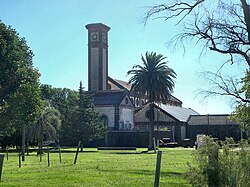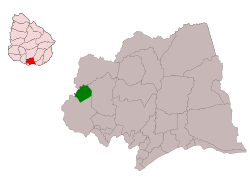Aguas Corrientes | |
|---|---|
Town | |
 The old water purification plant. | |
| Coordinates: 34°31′18″S56°23′36″W / 34.52167°S 56.39333°W | |
| Country | |
| Department | Canelones Department |
| Population (2011) | |
• Total | 1,047 |
| Time zone | UTC -3 |
| Postal code | 90701 |
| Dial plan | +598 433 (+5 digits) |
Aguas Corrientes is a small town in the Canelones Department of southern Uruguay. Its name (running waters) is derived from the installations of pumping, filtration and purification of water from the Santa Lucia River, which is the largest in the country, supplying drinking water to the departments of Montevideo and Canelones.
Contents
Aguas Corrientes is also the name of the municipality to which the town belongs.



